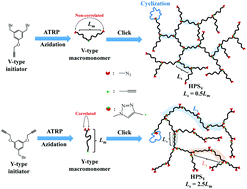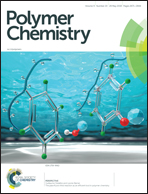A comparative study of intrachain cyclization and solution properties of long-subchain hyperbranched polymers prepared via Y-type and V-type macromonomer approaches†
Abstract
V-type (B∼∼A∼∼B) and Y-type (A∼∼∼∼B2) macromonomer approaches are two of the most widely adopted synthetic methodologies for the preparation of long-subchain hyperbranched polymers (LHPs) with a controlled subchain length. However, little attention has been paid to the difference of the structural regularity of hyperbranched polymers prepared via the two approaches in previous related studies. This work aims to elucidate how these two synthetic approaches quantitatively influence the polymerization, branching pattern and solution properties of the prepared hyperbranched polymers. First, two sets of model hyperbranched polystyrenes (HPSV and HPSY) were prepared from V-type and Y-type macromonomers by a combination of atom transfer radical polymerization (ATRP) and azide–alkyne cycloaddition coupling reaction, respectively. The intrachain cyclization study indicated that the macromonomer self-cyclization during the interchain coupling process was strongly affected by the chain length and the structure of the used macromonomer as well as the reaction concentration. The V-type macromonomer was found to be less inclined to undergo interchain coupling due to the stronger steric hindrance effect. Furthermore, via triple-detection size exclusion chromatography (TD-SEC) characterization, the intrinsic viscosity ([η]) and the radius of gyration (Rg) were found to be scaled to the molar mass of the macromonomer (Mm) and the molar mass of the entire chain (Mt) as [η] = KηMtνMmμ (μ ≃ 0.25 and ν ≃ 0.40) and Rg = HRMtαMmβ (α ≃ 0.47 and β ≃ 0.083) for both HPSV and HPSY samples. These scaling relationships evidenced that both HPSV and HPSY hyperbranched structures hold a similar statistically fractal feature. More importantly, the determined values of ratios Kη,Y/Kη,V (∼1.5) and HR,Y/HR,V (∼1.2) demonstrated, for the first time, that the average equivalent length of the branching subchain (Ls) for HPSY is much longer than the initial macromonomer chain length (Lm), i.e. Ls = 2.5Lm while Ls is exactly equal to 1/2Lm for HPSV. This finding clearly clarified the difference between Ls and Lm, and thus the terms of Ls and Lm should not be misused in the future structure–property study. Finally, the value of the Rg/Rη ratio is determined to be ∼1.05 and ∼1.15 for HPSV and HPSY samples (Rη: viscometric radius), respectively, which are much smaller than the typical values for linear chains in good solvents (1.20–1.40), revealing the less draining nature of these hyperbranched structures.



 Please wait while we load your content...
Please wait while we load your content...